 |
Introduction to Templates:Template syntax, Stack and Stash as templates |
| << Polymorphism & Virtual Functions:The problem, How C++ implements late binding |
| A: Coding Style >> |

16:
Introduction to
Templates
Inheritance
and composition provide a way to
reuse
object
code. The template
feature in C++
provides
a
way to reuse source
code.
723

Although
C++ templates are a general-purpose
programming tool,
when
they were introduced in the
language, they seemed to
discourage
the use of object-based
container-class hierarchies
(demonstrated
at the end of Chapter 15).
For example, the
Standard
C++
containers and algorithms (explained in
two chapters of
Volume
2 of this book, downloadable from
)
are
built
exclusively with templates and are
relatively easy for
the
programmer
to use.
This
chapter not only demonstrates the
basics of templates, it is
also
an
introduction to containers, which are
fundamental components
of
object-oriented programming and are
almost completely
realized
through
the containers in the
Standard C++ Library. You'll see
that
this
book has been using
container examples the
Stash
and
Stack
throughout, precisely to get you
comfortable with containers; in
this
chapter the concept of the
iterator
will also
be added. Although
containers
are ideal examples for use
with templates, in Volume 2
(which
has an advanced templates
chapter) you'll learn that
there
are
many other uses for templates as
well.
Containers
Suppose
you want to create a stack, as we have
been doing
throughout
the book. This stack
class will hold ints,
to keep it
simple:
//:
C16:IntStack.cpp
//
Simple integer stack
//{L}
fibonacci
#include
"fibonacci.h"
#include
"../require.h"
#include
<iostream>
using
namespace std;
class
IntStack {
enum
{ ssize = 100 };
int
stack[ssize];
int
top;
724
Thinking
in C++

public:
IntStack()
: top(0) {}
void
push(int i) {
require(top
< ssize, "Too many
push()es");
stack[top++]
= i;
}
int
pop() {
require(top
> 0, "Too many
pop()s");
return
stack[--top];
}
};
int
main() {
IntStack
is;
//
Add some Fibonacci numbers,
for interest:
for(int
i = 0; i < 20; i++)
is.push(fibonacci(i));
//
Pop & print them:
for(int
k = 0; k < 20; k++)
cout
<< is.pop() << endl;
}
///:~
The
class IntStackis
a trivial example of a push-down stack.
For
simplicity
it has been created here
with a fixed size, but you
can
also
modify it to automatically expand by
allocating memory off
the
heap, as in the Stack
class
that has been examined
throughout
the
book.
main(
) adds
some integers to the stack,
and pops them off again.
To
make the example more
interesting, the integers
are created
with
the fibonacci(
)function,
which generates the
traditional
rabbit-reproduction
numbers. Here is the header
file that declares
the
function:
//:
C16:fibonacci.h
//
Fibonacci number
generator
int
fibonacci(int n);
///:~
Here's
the implementation:
//:
C16:fibonacci.cpp {O}
#include
"../require.h"
16:
Introduction to Templates
725

int
fibonacci(int n) {
const
int sz = 100;
require(n
< sz);
static
int f[sz]; // Initialized to
zero
f[0]
= f[1] = 1;
//
Scan for unfilled array
elements:
int
i;
for(i
= 0; i < sz; i++)
if(f[i]
== 0) break;
while(i
<= n) {
f[i]
= f[i-1] + f[i-2];
i++;
}
return
f[n];
}
///:~
This
is a fairly efficient implementation,
because it never
generates
the
numbers more than once. It
uses a static
array
of int,
and relies
on
the fact that the
compiler will initialize a static
array
to zero. The
first
for
loop
moves the index i to
where the first array
element is
zero,
then a while
loop
adds Fibonacci numbers to
the array until
the
desired element is reached. But
notice that if the
Fibonacci
numbers
through element n
are
already initialized, it skips
the
while
loop
altogether.
The
need for containers
Obviously,
an integer stack isn't a
crucial tool. The real
need for
containers
comes when you start making
objects on the heap
using
new
and
destroying them with delete.
In the general
programming
problem,
you don't know how many objects you're
going to need
while
you're writing the program.
For example, in an
air-traffic
control
system you don't want to limit the number of
planes your
system
can handle. You don't want the
program to abort just
because
you exceed some number. In a
computer-aided design
system,
you're dealing with lots of
shapes, but only the
user
determines
(at runtime) exactly how many
shapes you're going to
need.
Once you notice this
tendency, you'll discover lots
of
examples
in your own programming
situations.
726
Thinking
in C++

C
programmers who rely on virtual memory to handle
their
"memory
management" often find the
idea of new,
delete,
and
container
classes disturbing. Apparently,
one practice in C is to
create
a huge global array, larger
than anything the program
would
appear
to need. This may not require much
thought (or awareness
of
malloc(
)and
free(
)),
but it produces programs that don't
port
well
and that hide subtle
bugs.
In
addition, if you create a huge
global array of objects in
C++, the
constructor
and destructor overhead can slow
things down
significantly.
The C++ approach works much better: When
you
need
an object, create it with new,
and
put its pointer in a
container.
Later on, fish it out and do
something to it. This
way,
you
create only the objects you
absolutely need. And usually you
don't
have all the initialization
conditions available at the
start-up
of
the program. new
allows
you to wait until something happens
in
the
environment before you can
actually create the
object.
So
in the most common
situation, you'll make a container
that
holds
pointers to some objects of
interest. You will create
those
objects
using new
and
put the resulting pointer in
the container
(potentially
upcasting it in the process), pulling it
out later when
you
want to do something with the object.
This technique
produces
the
most flexible, general sort
of program.
Overview
of templates
Now
a problem arises. You have an
IntStack
which
holds integers.
,
But
you want a stack that holds
shapes or aircraft or plants
or
something
else. Reinventing your source
code every time
doesn't
seem
like a very intelligent approach with a
language that touts
reusability.
There must be a better way.
There
are three techniques for
source code reuse in this
situation:
the
C way, presented here for contrast;
the Smalltalk
approach,
which
significantly affected C++; and
the C++ approach:
templates.
16:
Introduction to Templates
727

The
C solution Of course
you're trying to get away from the
C
.
approach
because it's messy and error
prone and completely
inelegant.
In this approach, you copy
the source code for a
Stack
and
make modifications by hand,
introducing new errors in
the
process.
This is certainly not a very productive
technique.
The
Smalltalk solutionSmalltalk
(and Java, following its
example)
.
took
a simple and straightforward approach:
You want to reuse
code,
so use inheritance. To implement
this, each container
class
holds
items of the generic base
class Object
(similar
to the example
at
the end of Chapter 15). But
because the library in
Smalltalk is of
such
fundamental importance, you don't ever
create a class from
scratch.
Instead, you must always inherit it from
an existing class.
You
find a class as close as possible to
the one you want,
inherit
from
it, and make a few changes.
Obviously, this is a
benefit
because
it minimizes your effort (and
explains why you spend a lot
of
time learning the class
library before becoming an
effective
Smalltalk
programmer).
But
it also means that all
classes in Smalltalk end up
being part of a
single
inheritance tree. You must inherit from a
branch of this tree
when
creating a new class. Most of the
tree is already there (it's
the
Smalltalk
class library), and at the
root of the tree is a class
called
Object
the same class that
each Smalltalk container
holds.
This
is a neat trick because it
means that every class in
the Smalltalk
can
be held in every container
(including that container
itself). This
type
of single-tree hierarchy based on a
fundamental generic type
(often
named Object,
which is also the case in
Java) is referred to as
an
"object-based hierarchy." You may have
heard this term and
assumed
it was some new fundamental
concept in OOP, like
polymorphism.
It simply refers to a class hierarchy
with Object
(or
1
With the exception, in
Java, of the primitive data
types. These were made
non-
Objects
for efficiency.
728
Thinking
in C++
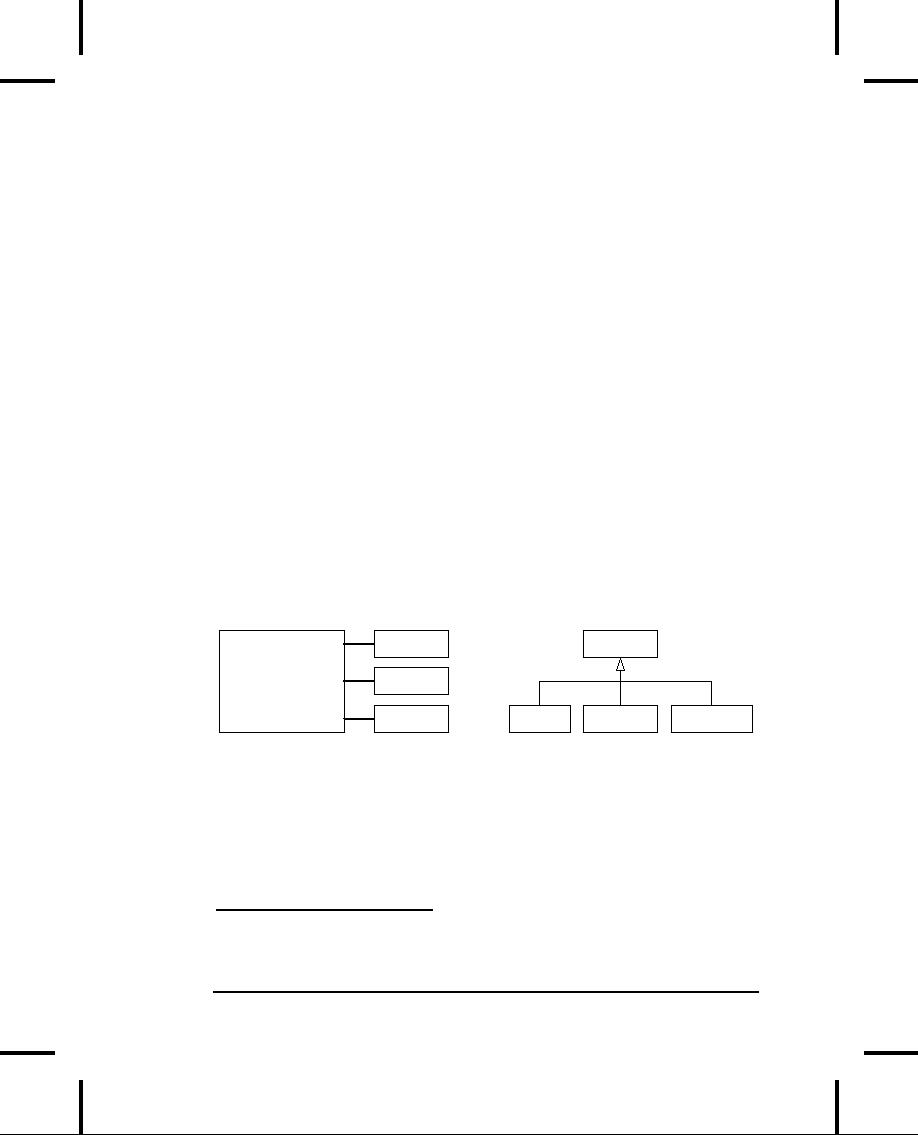
some
similar name) at its root
and container classes that hold
Object.
Because
the Smalltalk class library
had a much longer history and
experience
behind it than did C++, and because
the original C++
compilers
had no
container
class libraries, it seemed
like a good
idea
to duplicate the Smalltalk
library in C++. This was
done as an
represented
a significant body of code, many people
began using it.
In
the process of trying to use
the container classes, they
discovered
a
problem.
The
problem was that in
Smalltalk (and most other
OOP languages
that
I know of), all classes are
automatically derived from a
single
hierarchy,
but this isn't true in C++. You might
have your nice
object-based
hierarchy with its container
classes, but then you
might
buy a set of shape classes or aircraft
classes from another
vendor
who didn't use that hierarchy.
(For one thing, using
that
hierarchy
imposes overhead, which C programmers
eschew.) How
do
you insert a separate class
tree into the container
class in your
object-based
hierarchy? Here's what the
problem looks like:
(Not
derived
Object
Shape
from
Object)
Container
Object
(Holds
pointers
to
Objects)
Object
Circle
Square
Triangle
Because
C++ supports multiple independent
hierarchies,
Smalltalk's
object-based hierarchy does not work so
well.
The
solution seemed obvious. If you
can have many
inheritance
hierarchies,
then you should be able to inherit from
more than one
2
The OOPS library, by
Keith Gorlen while he was at
NIH.
16:
Introduction to Templates
729
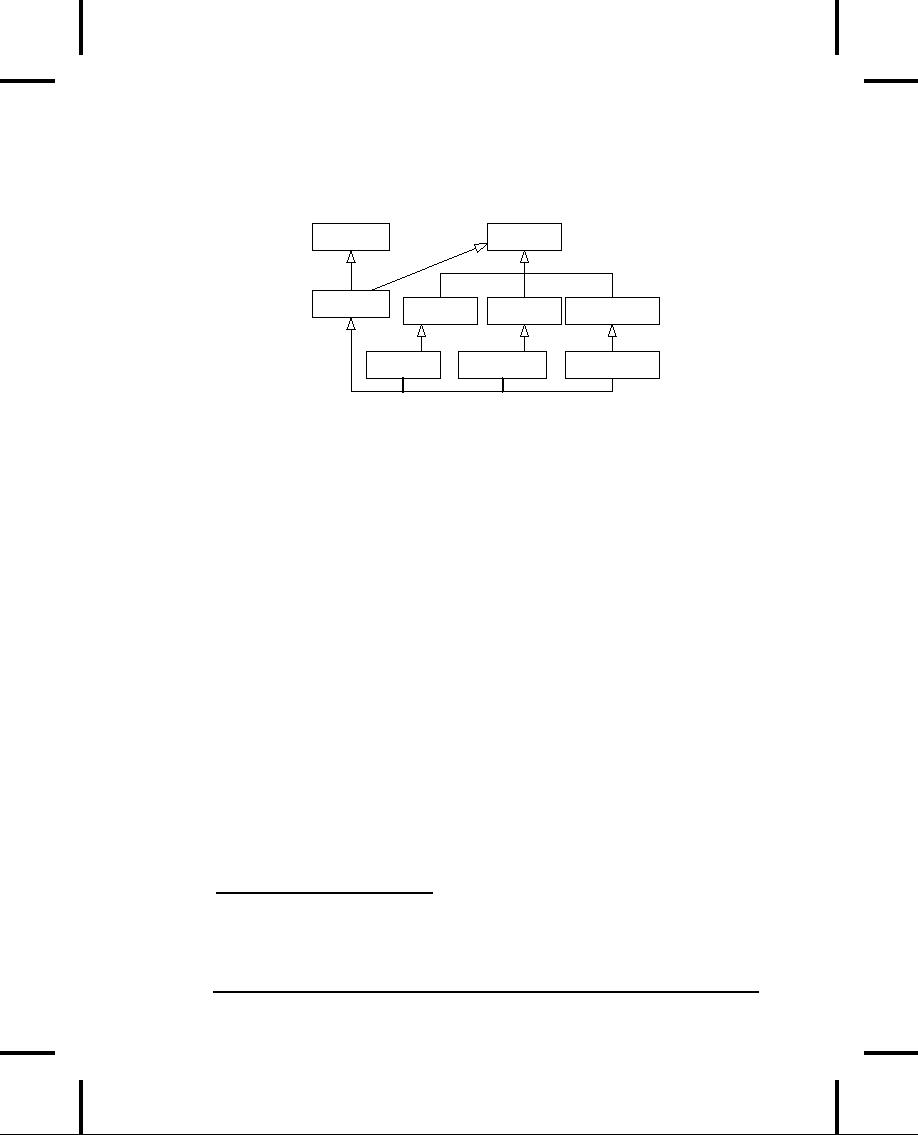
class:
Multiple inheritance will solve the
problem. So you do the
following
(a similar example was given
at the end of Chapter
15):
Object
Shape
OShape
Circle
Square
Triangle
OCircle
OSquare
OTriangle
Now
OShape
has
Shape's
characteristics and behaviors, but
because
it is also derived from Object
it
can be placed in Container
.
The
extra inheritance into OCircle,
OSquare,
etc. is necessary so
that
those classes can be upcast into
OShape
and
thus retain the
correct
behavior. You can see that
things are rapidly getting
messy.
Compiler
vendors invented and included
their own object-based
container-class
hierarchies, most of which have
since been replaced
by
template versions. You can
argue that multiple inheritance
is
needed
for solving general programming
problems, but you'll see
in
Volume 2 of this book that
its complexity is best
avoided except
in
special cases.
The
template solution
Although
an object-based hierarchy with multiple
inheritance is
conceptually
straightforward, it turns out to be painful to use.
In
preferable
alternative to the object-based
hierarchy. Container
classes
were created as large
preprocessor macros with
arguments
that
could be substituted with your desired
type. When you
3
The
C++ Programming Language by Bjarne
Stroustrup (1st edition,
Addison-Wesley,
1986).
730
Thinking
in C++
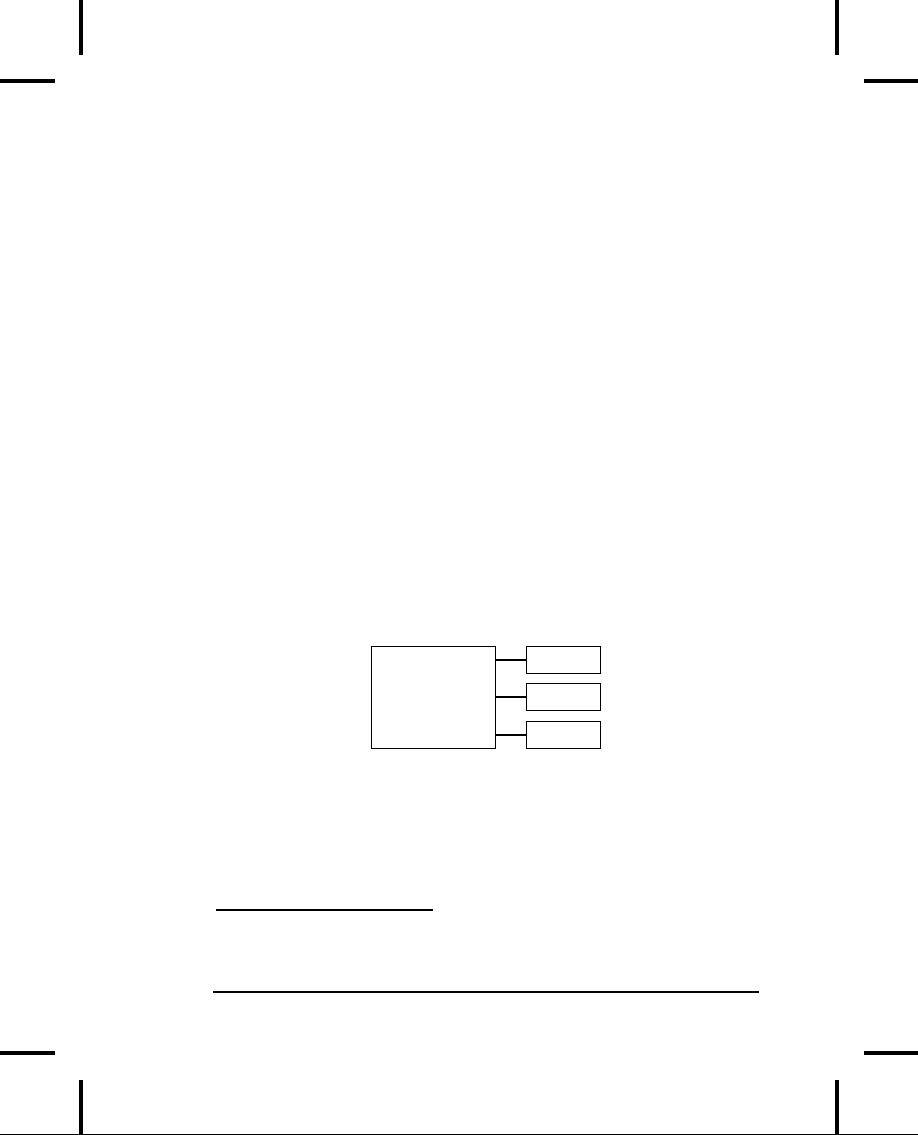
wanted
to create a container to hold a
particular type, you made
a
couple
of macro calls.
Unfortunately,
this approach was confused
by all the existing
Smalltalk
literature and programming experience,
and it was a bit
unwieldy.
Basically, nobody got
it.
In
the meantime, Stroustrup and
the C++ team at Bell Labs
had
modified
his original macro approach,
simplifying it and moving it
from
the domain of the
preprocessor into the compiler.
This new
code-substitution
device is called a template
, and it
represents a
completely
different way to reuse code.
Instead of reusing
object
code,
as with inheritance and composition, a
template reuses source
code. The
container no longer holds a
generic base class called
Object,
but instead it holds an unspecified
parameter. When you
use
a template, the parameter is
substituted by
the compiler, much
like
the old macro approach, but
cleaner and easier to
use.
Now,
instead of worrying about inheritance or
composition when
you
want to use a container class, you
take the template version
of
the
container and stamp out a specific
version for your particular
problem,
like this:
Shape
Shape
Shape
Container
Shape
The
compiler does the work for you, and you
end up with exactly
the
container you need to do your job,
rather than an unwieldy
inheritance
hierarchy. In C++, the
template implements the
concept
of
a parameterized
type. Another
benefit of the template
approach is
that
the novice programmer who may be
unfamiliar or
4
The inspiration for
templates appears to be ADA
generics.
16:
Introduction to Templates
731

uncomfortable
with inheritance can still
use canned container
classes
right away (as we've been doing with
vector
throughout
the
book).
Template
syntax
The
templatekeyword
tells the compiler that
the class definition
that
follows will manipulate one or
more unspecified types. At
the
time
the actual class code is
generated from the template,
those
types
must be specified so that the
compiler can substitute
them.
To
demonstrate the syntax,
here's a small example that
produces a
bounds-checked
array:
//:
C16:Array.cpp
#include
"../require.h"
#include
<iostream>
using
namespace std;
template<class
T>
class
Array {
enum
{ size = 100 };
T
A[size];
public:
T&
operator[](int index) {
require(index
>= 0 && index <
size,
"Index
out of range");
return
A[index];
}
};
int
main() {
Array<int>
ia;
Array<float>
fa;
for(int
i = 0; i < 20; i++) {
ia[i]
= i * i;
fa[i]
= float(i) * 1.414;
}
for(int
j = 0; j < 20; j++)
cout
<< j << ": " << ia[j]
<<
", " << fa[j] << endl;
732
Thinking
in C++

}
///:~
You
can see that it looks
like a normal class except for
the line
template<class
T>
which
says that T
is
the substitution parameter, and
that it
represents
a type name. Also, you see
T
used
everywhere in the
class
where you would normally see the
specific type the
container
holds.
In
Array,
elements are inserted and
extracted
with the same
function:
the overloaded operator
[ ]. It
returns a reference, so it
can
be used on both sides of an
equal sign (that is, as
both an lvalue
and
an rvalue). Notice
that if the index is out of
bounds, the
require(
)function
is used to print a message. Since
operator[]is
an
inline,
you could use this approach
to guarantee that no
array-
bounds
violations occur, then remove
the require(
)for
the
shipping
code.
In
main(
),
you can see how easy it is to
create Arrays
that hold
different
types of objects. When you
say
Array<int>
ia;
Array<float>
fa;
the
compiler expands the
Array
template
(this is called
instantiation) twice,
to create two new generated
classes, which
you
can
think of as Array_intand
Array_float
(Different
compilers
.
may
decorate the names in
different ways.) These are
classes just
like
the ones you would have
produced if you had performed
the
substitution
by hand, except that the
compiler creates them for you
as
you define the objects
ia
and
fa.
Also note that duplicate
class
definitions
are either avoided by the
compiler or merged by
the
linker.
16:
Introduction to Templates
733

Non-inline
function definitions
Of
course, there are times when
you'll want to have non-inline
member
function definitions. In this case,
the compiler needs to
see
the
templatedeclaration
before the member function
definition.
Here's
the example above, modified
to show the non-inline
member
definition:
//:
C16:Array2.cpp
//
Non-inline template
definition
#include
"../require.h"
template<class
T>
class
Array {
enum
{ size = 100 };
T
A[size];
public:
T&
operator[](int index);
};
template<class
T>
T&
Array<T>::operator[](int index)
{
require(index
>= 0 && index <
size,
"Index
out of range");
return
A[index];
}
int
main() {
Array<float>
fa;
fa[0]
= 1.414;
}
///:~
Any
reference to a template's class
name must be accompanied by
its
template argument list, as in
Array<T>::operator[]You
can
.
imagine
that internally, the class
name is being decorated with
the
arguments
in the template argument
list to produce a unique
class
name
identifier for each template
instantiation.
Header
files
Even
if you create non-inline function
definitions, you'll usually
want
to put all declarations and
definitions
for a template into a
header
file. This may seem to
violate the normal header
file rule of
734
Thinking
in C++

"Don't
put in anything that allocates
storage," (which prevents
multiple
definition errors at link time), but
template definitions
are
special.
Anything preceded by template<...>means
the compiler
won't
allocate storage for it at that
point, but will instead wait until
it's
told to (by a template instantiation), and
that somewhere in the
compiler
and linker there's a mechanism for
removing multiple
definitions
of an identical template. So you'll
almost always put the
entire
template declaration and
definition
in the header file, for
ease
of
use.
There
are times when you may need to
place the template
definitions
in a separate cpp
file
to satisfy special needs
(for
example,
forcing template instantiations to
exist in only a single
Windows
dll
file).
Most compilers have some
mechanism to allow
this;
you'll have to investigate your
particular compiler's
documentation
to use it.
Some
people feel that putting all of
the source code for
your
implementation
in a header file makes it
possible for people to
steal
and
modify your code if they buy a library from you.
This might be
an
issue, but it probably depends on
the way you look at
the
problem:
Are they buying a product or a service? If
it's a product,
then
you have to do everything you can to
protect it, and
probably
you
don't want to give source code,
just compiled code. But
many
people
see software as a service, and
even more than that,
a
subscription
service. The customer wants
your expertise, they want
you
to continue maintaining this
piece of reusable code so
that they
don't
have to so they can focus on
getting their
job
done. I
personally
think most customers will treat you as a
valuable
resource
and will not want to jeopardize their
relationship with
you.
As for the few who want to steal rather
than buy or do original
work,
they probably can't keep up with you
anyway.
IntStack
as a template
Here
is the container and iterator from
IntStack.cpp
implemented
,
as
a generic container class
using templates:
16:
Introduction to Templates
735

//:
C16:StackTemplate.h
//
Simple stack template
#ifndef
STACKTEMPLATE_H
#define
STACKTEMPLATE_H
#include
"../require.h"
template<class
T>
class
StackTemplate {
enum
{ ssize = 100 };
T
stack[ssize];
int
top;
public:
StackTemplate()
: top(0) {}
void
push(const T& i) {
require(top
< ssize, "Too many
push()es");
stack[top++]
= i;
}
T
pop() {
require(top
> 0, "Too many
pop()s");
return
stack[--top];
}
int
size() { return top;
}
};
#endif
// STACKTEMPLATE_H ///:~
Notice
that a template makes
certain assumptions about
the objects
it
is holding. For example,
StackTemplateassumes
there is some
sort
of assignment operation for T inside
the push(
) function.
You
could
say that a template "implies
an interface" for the types it
is
capable
of holding.
Another
way to say this is that
templates provide a kind of weak
typing
mechanism
for C++, which is ordinarily a
strongly-typed
language.
Instead of insisting that an
object be of some exact type
in
order
to be acceptable, weak typing requires
only that the member
functions
that it wants to call are
available
for a
particular object.
Thus,
weakly-typed code can be
applied to any object that
can
736
Thinking
in C++

accept
those member function calls,
and is thus much more
Here's
the revised example to test
the template:
//:
C16:StackTemplateTest.cpp
//
Test simple stack
template
//{L}
fibonacci
#include
"fibonacci.h"
#include
"StackTemplate.h"
#include
<iostream>
#include
<fstream>
#include
<string>
using
namespace std;
int
main() {
StackTemplate<int>
is;
for(int
i = 0; i < 20; i++)
is.push(fibonacci(i));
for(int
k = 0; k < 20; k++)
cout
<< is.pop() << endl;
ifstream
in("StackTemplateTest.cpp");
assure(in,
"StackTemplateTest.cpp");
string
line;
StackTemplate<string>
strings;
while(getline(in,
line))
strings.push(line);
while(strings.size()
> 0)
cout
<< strings.pop() <<
endl;
}
///:~
The
only difference is in the creation of
is.
Inside the template
argument
list you specify the type of
object the stack and
iterator
should
hold. To demonstrate the
genericness of the template,
a
StackTemplateis
also created to hold string.
This is tested by
reading
in lines from the source-code
file.
5
All methods in both
Smalltalk and Python are
weakly typed, and so
those
languages
do not need a template
mechanism. In effect, you
get templates without
templates.
16:
Introduction to Templates
737
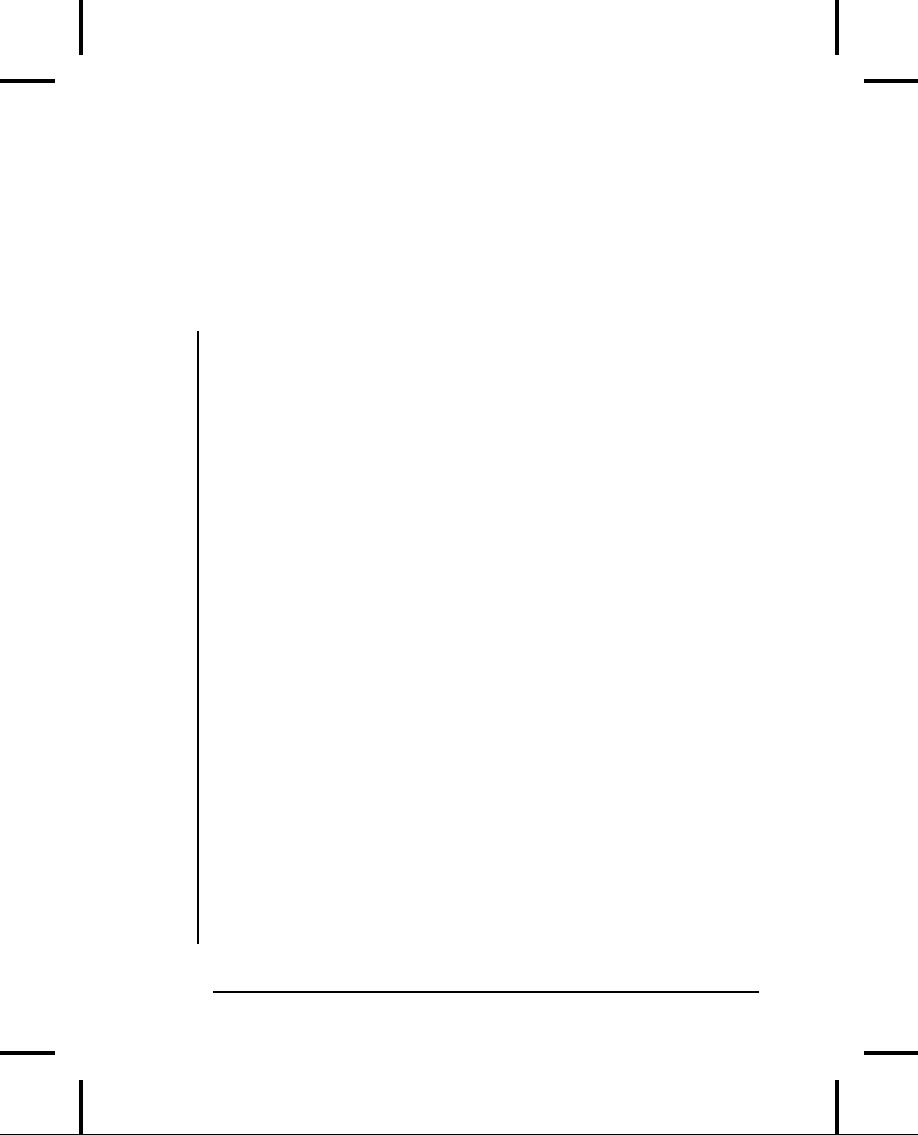
Constants
in templates
Template
arguments are not restricted to
class types; you can
also
use
built-in types. The values
of these arguments then
become
compile-time
constants for that particular
instantiation of the
template.
You can even use default
values for these arguments.
The
following
example allows you to set
the size of the Array
class
during
instantiation, but also provides a
default value:
//:
C16:Array3.cpp
//
Built-in types as template
arguments
#include
"../require.h"
#include
<iostream>
using
namespace std;
template<class
T, int size = 100>
class
Array {
T
array[size];
public:
T&
operator[](int index) {
require(index
>= 0 && index <
size,
"Index
out of range");
return
array[index];
}
int
length() const { return
size; }
};
class
Number {
float
f;
public:
Number(float
ff = 0.0f) : f(ff)
{}
Number&
operator=(const Number&
n)
{
f
= n.f;
return
*this;
}
operator
float() const {
return
f;
}
friend
ostream&
operator<<(ostream&
os, const
Number&
x) {
return
os << x.f;
}
};
template<class
T, int size = 20>
738
Thinking
in C++

class
Holder {
Array<T,
size>* np;
public:
Holder()
: np(0) {}
T&
operator[](int i) {
require(0
<= i && i < size);
if(!np)
np = new Array<T,
size>;
return
np->operator[](i);
}
int
length() const { return
size; }
~Holder()
{ delete np; }
};
int
main() {
Holder<Number>
h;
for(int
i = 0;
i
< 20; i++)
h[i]
= i;
for(int
j = 0;
j
< 20; j++)
cout
<< h[j]
<<
endl;
}
///:~
As
before, Array
is
a checked array of objects and
prevents you
from
indexing out of bounds. The
class Holder
is
much like Array
except
that it has a pointer to an
Array
instead
of an embedded
object
of type Array.
This pointer is not initialized in
the
constructor;
the initialization is delayed until
the first access. This
is
called
lazy
initialization; you might
use a technique like this if
you
are
creating a lot of objects, but not
accessing them all, and want to
save
storage.
You'll
notice that the size
value
in both templates is never
stored
internally
in the class, but it is used as if it
were a data member
inside
the member functions.
Stack
and Stash
as
templates
The
recurring "ownership" problems with
the Stash
and
Stack
container
classes that have been
revisited throughout this
book
come
from the fact that these
containers haven't been able
to know
16:
Introduction to Templates
739

exactly
what types they hold. The
nearest they've come is the
Stack
"container
of Object"
that was seen at the
end of Chapter 15 in
OStackTest.cpp
.
If
the client programmer
doesn't explicitly remove all
the pointers
to
objects that are held in the
container, then the container
should
be
able to correctly delete
those pointers. That is to say,
the
container
"owns" any objects that haven't
been removed, and is
thus
responsible for cleaning them up. The
snag has been
that
cleanup
requires knowing the type of the
object, and creating a
generic
container class requires
not
knowing
the type of the object.
With
templates, however, we can write
code that doesn't know
the
type
of the object, and easily
instantiate a new version of
that
container
for every type that we want to contain.
The individual
instantiated
containers do
know the
type of objects they hold and
can
thus call the correct
destructor (assuming, in the
typical case
where
polymorphism is involved, that a virtual
destructor has been
provided).
For
the Stack
this
turns out to be quite simple since all of
the
member
functions can be reasonably
inlined:
//:
C16:TStack.h
//
The Stack as a
template
#ifndef
TSTACK_H
#define
TSTACK_H
template<class
T>
class
Stack {
struct
Link {
T*
data;
Link*
next;
Link(T*
dat, Link* nxt):
data(dat),
next(nxt) {}
}*
head;
public:
Stack()
: head(0) {}
~Stack(){
while(head)
delete
pop();
740
Thinking
in C++

}
void
push(T* dat) {
head
= new Link(dat,
head);
}
T*
peek() const {
return
head ? head->data : 0;
}
T*
pop(){
if(head
== 0) return 0;
T*
result = head->data;
Link*
oldHead = head;
head
= head->next;
delete
oldHead;
return
result;
}
};
#endif
// TSTACK_H ///:~
If
you compare this to the
OStack.hexample
at the end of Chapter
15,
you will see that Stack
is
virtually identical, except that
Object
has
been replaced with T.
The test program is also
nearly identical,
except
that the necessity for
multiply-inheriting from string
and
Object
(and
even the need for Object
itself)
has been eliminated.
Now
there is no MyStringclass
to announce its destruction, so
a
small
new class is added to show a Stack
container
cleaning up its
objects:
//:
C16:TStackTest.cpp
//{T}
TStackTest.cpp
#include
"TStack.h"
#include
"../require.h"
#include
<fstream>
#include
<iostream>
#include
<string>
using
namespace std;
class
X {
public:
virtual
~X() { cout << "~X " <<
endl; }
};
int
main(int argc, char* argv[])
{
requireArgs(argc,
1); // File name is
argument
16:
Introduction to Templates
741

ifstream
in(argv[1]);
assure(in,
argv[1]);
Stack<string>
textlines;
string
line;
//
Read file and store
lines in the Stack:
while(getline(in,
line))
textlines.push(new
string(line));
//
Pop some lines from
the stack:
string*
s;
for(int
i = 0; i < 10; i++) {
if((s
= (string*)textlines.pop())==0)
break;
cout
<< *s << endl;
delete
s;
}
// The destructor deletes
the other strings.
//
Show that correct
destruction happens:
Stack<X>
xx;
for(int
j = 0; j < 10; j++)
xx.push(new
X);
}
///:~
The
destructor for X
is
virtual, not because it's
necessary here, but
because
xx
could
later be used to hold objects
derived from X.
Notice
how easy it is to create different
kinds of Stacks
for string
and
for X.
Because of the template, you
get the best of both
worlds:
the
ease of use of the Stack
class
along with proper
cleanup.
Templatized
pointer Stash
Reorganizing
the PStash
code
into a template isn't quite so
simple
because
there are a number of member
functions that should not
be
inlined.
However, as a template those function
definitions still
belong
in the header file (the
compiler and linker take
care of any
multiple
definition problems). The
code looks quite similar to
the
ordinary
PStash
except
that you'll notice the size
of the increment
(used
by inflate(
) has
been templatized as a non-class
parameter
with
a default value, so that the
increment size can be
modified at
the
point of instantiation (notice
that this means that
the increment
size
is fixed; you may also argue
that the increment size
should be
changeable
throughout the lifetime of the
object):
742
Thinking
in C++

//:
C16:TPStash.h
#ifndef
TPSTASH_H
#define
TPSTASH_H
template<class
T, int incr = 10>
class
PStash {
int
quantity; // Number of storage
spaces
int
next; // Next empty
space
T**
storage;
void
inflate(int increase =
incr);
public:
PStash()
: quantity(0), next(0), storage(0)
{}
~PStash();
int
add(T* element);
T*
operator[](int index) const; //
Fetch
//
Remove the reference from
this PStash:
T*
remove(int index);
//
Number of elements in
Stash:
int
count() const { return next;
}
};
template<class
T, int incr>
int
PStash<T, incr>::add(T* element)
{
if(next
>= quantity)
inflate(incr);
storage[next++]
= element;
return(next
- 1); // Index number
}
//
Ownership of remaining
pointers:
template<class
T, int incr>
PStash<T,
incr>::~PStash() {
for(int
i = 0; i < next; i++) {
delete
storage[i]; // Null pointers
OK
storage[i]
= 0; // Just to be safe
}
delete
[]storage;
}
template<class
T, int incr>
T*
PStash<T, incr>::operator[](int
index) const {
require(index
>= 0,
"PStash::operator[]
index negative");
if(index
>= next)
return
0; // To indicate the
end
16:
Introduction to Templates
743

require(storage[index]
!= 0,
"PStash::operator[]
returned null
pointer");
//
Produce pointer to desired
element:
return
storage[index];
}
template<class
T, int incr>
T*
PStash<T, incr>::remove(int index)
{
//
operator[] performs validity
checks:
T*
v = operator[](index);
//
"Remove" the pointer:
if(v
!= 0) storage[index] = 0;
return
v;
}
template<class
T, int incr>
void
PStash<T, incr>::inflate(int
increase) {
const
int psz = sizeof(T*);
T**
st = new T*[quantity +
increase];
memset(st,
0, (quantity + increase) *
psz);
memcpy(st,
storage, quantity *
psz);
quantity
+= increase;
delete
[]storage; // Old
storage
storage
= st; // Point to new
memory
}
#endif
// TPSTASH_H ///:~
The
default increment size used
here is small to guarantee
that calls
to
inflate(
)occur.
This way we can make sure it
works correctly.
To
test the ownership control
of the templatized PStash,
the
following
class will report creations and
destructions of itself, and
also
guarantee that all objects
that have been created
were also
destroyed.
AutoCounterwill
allow only objects of its type to
be
created
on the stack:
//:
C16:AutoCounter.h
#ifndef
AUTOCOUNTER_H
#define
AUTOCOUNTER_H
#include
"../require.h"
#include
<iostream>
#include
<set> // Standard C++
Library container
#include
<string>
744
Thinking
in C++

class
AutoCounter {
static
int count;
int
id;
class
CleanupCheck {
std::set<AutoCounter*>
trace;
public:
void
add(AutoCounter* ap) {
trace.insert(ap);
}
void
remove(AutoCounter* ap) {
require(trace.erase(ap)
== 1,
"Attempt
to delete AutoCounter
twice");
}
~CleanupCheck()
{
std::cout
<< "~CleanupCheck()"<<
std::endl;
require(trace.size()
== 0,
"All
AutoCounter objects not
cleaned up");
}
};
static
CleanupCheck verifier;
AutoCounter()
: id(count++) {
verifier.add(this);
// Register itself
std::cout
<< "created[" << id <<
"]"
<<
std::endl;
}
//
Prevent assignment and
copy-construction:
AutoCounter(const
AutoCounter&);
void
operator=(const AutoCounter&);
public:
//
You can only create
objects with this:
static
AutoCounter* create() {
return
new AutoCounter();
}
~AutoCounter()
{
std::cout
<< "destroying[" << id
<<
"]" << std::endl;
verifier.remove(this);
}
//
Print both objects and
pointers:
friend
std::ostream&
operator<<(
std::ostream&
os, const AutoCounter&
ac){
return
os << "AutoCounter " <<
ac.id;
}
friend
std::ostream&
operator<<(
16:
Introduction to Templates
745

std::ostream&
os, const AutoCounter*
ac){
return
os << "AutoCounter " <<
ac->id;
}
};
#endif
// AUTOCOUNTER_H ///:~
The
AutoCounterclass
does two things. First, it
sequentially
numbers
each instance of AutoCounter
the
value of this number is
:
kept
in id,
and the number is generated using
the static
data
member
count.
Second,
and more complex, a static
instance
(called verifier
of
the
)
nested
class CleanupCheckkeeps
track of all of the AutoCounter
objects
that are created and
destroyed, and reports back to you
if
you
don't clean all of them up (i.e. if there
is a memory leak). This
behavior
is accomplished using a set
class
from the Standard C++
Library,
which is a wonderful example of how
well-designed
templates
can make life easy (you
can learn about all the
containers
in
the Standard C++ Library in Volume 2 of
this book, available
online).
The
set
class
is templatized on the type that it
holds; here it is
instantiated
to hold AutoCounterpointers.
A set
will
allow only
one
instance of each distinct
object to be added; in add(
) you
can
see
this take place with the
set::insert(
)function.
insert(
)actually
informs
you with its return value if you're
trying to add something
that's
already been added; however,
since object addresses
are
being
added we can rely on C++'s
guarantee that all objects
have
unique
addresses.
In
remove(
) set::erase( )is used to
remove an AutoCounter
,
pointer
from the set.
The return value tells you how many
instances
of
the element were removed; in
our case we only expect zero
or
one.
If the value is zero,
however, it means this
object was already
deleted
from the set
and
you're trying to delete it a second
time,
which
is a programming error that will be
reported through
require(
)
.
746
Thinking
in C++

The
destructor for CleanupCheckdoes
a final check by
making
sure
that the size of the
set
is
zero this means that
all of the objects
have
been properly cleaned up. If
it's not zero, you have a
memory
leak,
which is reported through require(
)
.
The
constructor and destructor for AutoCounterregister
and
unregister
themselves with the verifierobject.
Notice that the
constructor,
copy-constructor, and assignment operator
are private,
so
the only way for you to create an object
is with the static
create( )
member
function this is a simple
example of a factory, and it
guarantees
that all objects are created
on the heap, so verifierwill
not
get confused over
assignments and
copy-constructions.
Since
all of the member functions
have been inlined, the
only
reason
for the implementation file is to
contain the static
data
member
definitions:
//:
C16:AutoCounter.cpp {O}
//
Definition of static class
members
#include
"AutoCounter.h"
AutoCounter::CleanupCheck
AutoCounter::verifier;
int
AutoCounter::count = 0;
///:~
With
AutoCounterin
hand, we can now test the
facilities of the
PStash.
The following example not only shows
that the PStash
destructor
cleans up all the objects
that it currently owns, but it
also
demonstrates
how the AutoCounterclass
detects objects that
haven't
been cleaned up:
//:
C16:TPStashTest.cpp
//{L}
AutoCounter
#include
"AutoCounter.h"
#include
"TPStash.h"
#include
<iostream>
#include
<fstream>
using
namespace std;
int
main() {
PStash<AutoCounter>
acStash;
16:
Introduction to Templates
747

for(int
i = 0; i < 10; i++)
acStash.add(AutoCounter::create());
cout
<< "Removing 5 manually:" <<
endl;
for(int
j = 0; j < 5; j++)
delete
acStash.remove(j);
cout
<< "Remove two without
deleting them:"
<<
endl;
//
... to generate the cleanup
error message.
cout
<< acStash.remove(5) <<
endl;
cout
<< acStash.remove(6) <<
endl;
cout
<< "The destructor cleans up
the rest:"
<<
endl;
//
Repeat the test from
earlier chapters:
ifstream
in("TPStashTest.cpp");
assure(in,
"TPStashTest.cpp");
PStash<string>
stringStash;
string
line;
while(getline(in,
line))
stringStash.add(new
string(line));
//
Print out the
strings:
for(int
u = 0; stringStash[u]; u++)
cout
<< "stringStash[" << u << "] =
"
<<
*stringStash[u] << endl;
}
///:~
When
AutoCounterelements
5 and 6 are removed from
the
PStash,
they become the responsibility of
the caller, but since
the
caller
never cleans them up they cause memory
leaks, which are
then
detected by AutoCounterat
run time.
When
you run the program, you'll see
that the error message
isn't
as
specific as it could be. If you
use the scheme presented
in
AutoCounterto
discover memory leaks in your own system,
you
will
probably want to have it print out more
detailed information
about
the objects that haven't
been cleaned up. Volume 2 of
this
book
shows more sophisticated ways to do
this.
Turning
ownership on and off
Let's
return to the ownership problem.
Containers that hold
objects
by
value don't usually worry about ownership
because they clearly
748
Thinking
in C++

own
the objects they contain. But if your
container holds
pointers
(which
is more common with C++,
especially with polymorphism),
then
it's very likely those
pointers may also be used
somewhere
else
in the program, and you don't necessarily
want to delete the
object
because then the other
pointers in the program would
be
referencing
a destroyed object. To prevent
this from happening,
you
must consider ownership when designing
and using a
container.
Many
programs are much simpler than
this, and don't encounter
the
ownership problem: One container
holds pointers to
objects
that
are used only by that
container. In this case
ownership is very
straightforward:
The container owns its
objects.
The
best approach to handling
the ownership problem is to
give the
client
programmer a choice. This is
often accomplished by a
constructor
argument that defaults to
indicating ownership
(the
simplest
case). In addition there may be "get" and
"set" functions
to
view and modify the ownership of the
container. If the
container
has
functions to remove an object,
the ownership state
usually
affects
that removal, so you may also find
options to control
destruction
in the removal function. You
could conceivably add
ownership
data for every element in
the container, so each
position
would
know whether it needed to be destroyed;
this is a variant of
reference
counting, except that the
container and not the
object
knows
the number of references pointing to an
object.
//:
C16:OwnerStack.h
//
Stack with runtime
conrollable ownership
#ifndef
OWNERSTACK_H
#define
OWNERSTACK_H
template<class
T> class Stack {
struct
Link {
T*
data;
Link*
next;
Link(T*
dat, Link* nxt)
:
data(dat), next(nxt) {}
}*
head;
16:
Introduction to Templates
749

bool
own;
public:
Stack(bool
own = true) : head(0),
own(own) {}
~Stack();
void
push(T* dat) {
head
= new Link(dat,head);
}
T*
peek() const {
return
head ? head->data : 0;
}
T*
pop();
bool
owns() const { return own;
}
void
owns(bool newownership) {
own
= newownership;
}
//
Auto-type conversion: true if
not empty:
operator
bool() const { return head
!= 0; }
};
template<class
T> T* Stack<T>::pop() {
if(head
== 0) return 0;
T*
result = head->data;
Link*
oldHead = head;
head
= head->next;
delete
oldHead;
return
result;
}
template<class
T> Stack<T>::~Stack() {
if(!own)
return;
while(head)
delete
pop();
}
#endif
// OWNERSTACK_H ///:~
The
default behavior is for the
container to destroy its
objects but
you
can change this by either
modifying the constructor
argument
or
using the owns(
) read/write
member functions.
As
with most templates you're likely to
see, the entire
implementation
is contained in the header
file. Here's a small
test
that
exercises the ownership
abilities:
750
Thinking
in C++

//:
C16:OwnerStackTest.cpp
//{L}
AutoCounter
#include
"AutoCounter.h"
#include
"OwnerStack.h"
#include
"../require.h"
#include
<iostream>
#include
<fstream>
#include
<string>
using
namespace std;
int
main() {
Stack<AutoCounter>
ac; // Ownership on
Stack<AutoCounter>
ac2(false); // Turn it
off
AutoCounter*
ap;
for(int
i = 0; i < 10; i++) {
ap
= AutoCounter::create();
ac.push(ap);
if(i
% 2 == 0)
ac2.push(ap);
}
while(ac2)
cout
<< ac2.pop() << endl;
//
No destruction necessary
since
//
ac "owns" all the
objects
}
///:~
The
ac2
object
doesn't own the objects you put into
it, thus ac
is
the
"master"
container which takes responsibility for
ownership. If,
partway
through the lifetime of a container, you
want to change
whether
a container owns its objects, you
can do so using owns(
).
It
would also be possible to change
the granularity of
the
ownership
so that it is on an object-by-object
basis, but that will
probably
make the solution to the
ownership problem
more
complex
than the problem.
Holding
objects by value
Actually
creating a copy of the
objects inside a generic
container is
a
complex problem if you don't have
templates. With templates,
16:
Introduction to Templates
751

things
are relatively simple you
just say that you are
holding
objects
rather than pointers:
//:
C16:ValueStack.h
//
Holding objects by value in a
Stack
#ifndef
VALUESTACK_H
#define
VALUESTACK_H
#include
"../require.h"
template<class
T, int ssize =
100>
class
Stack {
//
Default constructor performs
object
//
initialization for each
element in array:
T
stack[ssize];
int
top;
public:
Stack()
: top(0) {}
//
Copy-constructor copies object
into array:
void
push(const T& x) {
require(top
< ssize, "Too many
push()es");
stack[top++]
= x;
}
T
peek() const { return
stack[top]; }
//
Object still exists when
you pop it;
//
it just isn't available
anymore:
T
pop() {
require(top
> 0, "Too many
pop()s");
return
stack[--top];
}
};
#endif
// VALUESTACK_H ///:~
The
copy constructor for the
contained objects does most
of the
work
by passing and returning the
objects by value. Inside
push(
),
storage
of the object onto the
Stack
array
is accomplished with
T::operator=
To
guarantee that it works, a
class called SelfCounter
.
keeps
track of object creations and
copy-constructions:
//:
C16:SelfCounter.h
#ifndef
SELFCOUNTER_H
#define
SELFCOUNTER_H
#include
"ValueStack.h"
#include
<iostream>
752
Thinking
in C++

class
SelfCounter {
static
int counter;
int
id;
public:
SelfCounter()
: id(counter++) {
std::cout
<< "Created: " << id <<
std::endl;
}
SelfCounter(const
SelfCounter& rv) :
id(rv.id){
std::cout
<< "Copied: " << id <<
std::endl;
}
SelfCounter
operator=(const SelfCounter& rv)
{
std::cout
<< "Assigned " << rv.id << " to
"
<<
id << std::endl;
return
*this;
}
~SelfCounter()
{
std::cout
<< "Destroyed: "<< id <<
std::endl;
}
friend
std::ostream&
operator<<(
std::ostream&
os, const SelfCounter&
sc){
return
os << "SelfCounter: " <<
sc.id;
}
};
#endif
// SELFCOUNTER_H ///:~
//:
C16:SelfCounter.cpp {O}
#include
"SelfCounter.h"
int
SelfCounter::counter = 0; ///:~
//:
C16:ValueStackTest.cpp
//{L}
SelfCounter
#include
"ValueStack.h"
#include
"SelfCounter.h"
#include
<iostream>
using
namespace std;
int
main() {
Stack<SelfCounter>
sc;
for(int
i = 0; i < 10; i++)
sc.push(SelfCounter());
//
OK to peek(), result is a
temporary:
cout
<< sc.peek() << endl;
for(int
k = 0; k < 10; k++)
cout
<< sc.pop() << endl;
16:
Introduction to Templates
753

}
///:~
When
a Stack
container
is created, the default
constructor of the
contained
object is called for each
object in the array. You'll
initially
see
100 SelfCounterobjects
created for no apparent reason, but
this
is
just the array
initialization. This can be a
bit expensive, but
there's
no way around it in a simple design
like this. An even
more
complex
situation arises if you make
the Stack
more
general by
allowing
the size to grow dynamically,
because in the
implementation
shown above this would involve creating a
new
(larger)
array, copying the old array
to the new, and destroying
the
old
array (this is, in fact,
what the Standard C++ Library
vector
class
does).
Introducing
iterators
An
iterator
is an
object that moves through a
container of other
objects
and selects them one at a time, without
providing direct
access
to the implementation of that
container. Iterators provide
a
standard
way to access elements, whether or not a
container
provides
a way to access the elements
directly. You will see
iterators
used most often in
association with container classes,
and
iterators
are a fundamental concept in
the design and use of
the
Standard
C++ containers, which are fully described
in Volume 2 of
this
book (downloadable from ). An
iterator is
also
a kind of design
pattern, which is
the subject of a chapter in
Volume
2.
In
many ways, an iterator is a "smart
pointer," and in fact you'll
notice
that iterators usually mimic
most pointer operations.
Unlike
a
pointer, however, the
iterator is designed to be safe, so
you're
much
less likely to do the
equivalent of walking off the end of
an
array
(or if you do, you find out about it
more easily).
Consider
the first example in this
chapter. Here it is with a
simple
iterator
added:
754
Thinking
in C++

//:
C16:IterIntStack.cpp
//
Simple integer stack with
iterators
//{L}
fibonacci
#include
"fibonacci.h"
#include
"../require.h"
#include
<iostream>
using
namespace std;
class
IntStack {
enum
{ ssize = 100 };
int
stack[ssize];
int
top;
public:
IntStack()
: top(0) {}
void
push(int i) {
require(top
< ssize, "Too many
push()es");
stack[top++]
= i;
}
int
pop() {
require(top
> 0, "Too many
pop()s");
return
stack[--top];
}
friend
class IntStackIter;
};
//
An iterator is like a "smart"
pointer:
class
IntStackIter {
IntStack&
s;
int
index;
public:
IntStackIter(IntStack&
is) : s(is), index(0)
{}
int
operator++() { // Prefix
require(index
< s.top,
"iterator
moved out of range");
return
s.stack[++index];
}
int
operator++(int) { // Postfix
require(index
< s.top,
"iterator
moved out of range");
return
s.stack[index++];
}
};
int
main() {
IntStack
is;
16:
Introduction to Templates
755

for(int
i = 0; i < 20; i++)
is.push(fibonacci(i));
//
Traverse with an
iterator:
IntStackIter
it(is);
for(int
j = 0; j < 20; j++)
cout
<< it++ << endl;
}
///:~
The
IntStackIterhas
been created to work only with an
IntStack
.
Notice
that IntStackIteris
a friend
of
IntStack
which
gives it
,
access
to all the private
elements
of IntStack
.
Like
a pointer, IntStackIter
job
is to move through an IntStack
's
and
retrieve values. In this
simple example, the
IntStackItercan
move
only forward (using both the
pre- and postfix forms of
the
operator++
However,
there is no boundary to the way an
iterator
).
can
be defined, other than those
imposed by the constraints of
the
container
it works with. It is perfectly acceptable (within
the limits
of
the underlying container) for an iterator
to move around in any
way
within its associated container and to
cause the contained
values
to be modified.
It
is customary that an iterator is
created with a constructor
that
attaches
it to a single container object, and
that the iterator is
not
attached
to a different container during its
lifetime. (Iterators
are
usually
small and cheap, so you can
easily make another
one.)
With
the iterator, you can
traverse the elements of the
stack without
popping
them, just as a pointer can
move through the elements of
an
array. However, the iterator knows
the underlying structure of
the
stack and how to traverse the
elements, so even though you
are
moving
through them by pretending to "increment a
pointer,"
what's
going on underneath is more
involved. That's the key to
the
iterator:
It is abstracting the complicated
process of moving from
one
container element to the next into
something that looks like
a
pointer.
The goal is for every
iterator
in your program to have the
same
interface so that any code
that uses the iterator
doesn't care
what
it's pointing to it just knows
that it can reposition
all
756
Thinking
in C++

iterators
the same way, so the
container that the iterator
points to is
unimportant.
In this way you can write more
generic code. All of
the
containers and algorithms in the
Standard C++ Library
are
based
on this principle of
iterators.
To
aid in making things more
generic, it would be nice to be able
to
say
"every container has an associated
class called iterator
but
,"
this
will typically cause naming
problems. The solution is to
add a
nested
iteratorclass
to each container (notice
that in this case,
"iterator
begins
with a lowercase letter so that it
conforms to the
"
style
of the Standard C++ Library).
Here is IterIntStack.cpp
with
a
nested
iterator
:
//:
C16:NestedIterator.cpp
//
Nesting an iterator inside
the container
//{L}
fibonacci
#include
"fibonacci.h"
#include
"../require.h"
#include
<iostream>
#include
<string>
using
namespace std;
class
IntStack {
enum
{ ssize = 100 };
int
stack[ssize];
int
top;
public:
IntStack()
: top(0) {}
void
push(int i) {
require(top
< ssize, "Too many
push()es");
stack[top++]
= i;
}
int
pop() {
require(top
> 0, "Too many
pop()s");
return
stack[--top];
}
class
iterator;
friend
class iterator;
class
iterator {
IntStack&
s;
int
index;
public:
16:
Introduction to Templates
757

iterator(IntStack&
is) : s(is), index(0)
{}
//
To create the "end sentinel"
iterator:
iterator(IntStack&
is, bool)
:
s(is), index(s.top) {}
int
current() const { return
s.stack[index]; }
int
operator++() { // Prefix
require(index
< s.top,
"iterator
moved out of range");
return
s.stack[++index];
}
int
operator++(int) { // Postfix
require(index
< s.top,
"iterator
moved out of range");
return
s.stack[index++];
}
//
Jump an iterator
forward
iterator&
operator+=(int amount) {
require(index
+ amount < s.top,
"IntStack::iterator::operator+=()
"
"tried
to move out of
bounds");
index
+= amount;
return
*this;
}
//
To see if you're at the
end:
bool
operator==(const iterator& rv) const
{
return
index == rv.index;
}
bool
operator!=(const iterator& rv) const
{
return
index != rv.index;
}
friend
ostream&
operator<<(ostream&
os, const iterator& it)
{
return
os << it.current();
}
};
iterator
begin() { return iterator(*this);
}
//
Create the "end
sentinel":
iterator
end() { return iterator(*this,
true);}
};
int
main() {
IntStack
is;
for(int
i = 0; i < 20; i++)
is.push(fibonacci(i));
cout
<< "Traverse the whole
IntStack\n";
758
Thinking
in C++

IntStack::iterator
it = is.begin();
while(it
!= is.end())
cout
<< it++ << endl;
cout
<< "Traverse a portion of the
IntStack\n";
IntStack::iterator
start
= is.begin(), end =
is.begin();
start
+= 5, end += 15;
cout
<< "start = " << start <<
endl;
cout
<< "end = " << end <<
endl;
while(start
!= end)
cout
<< start++ << endl;
}
///:~
When
making a nested friend
class,
you must go through the
process
of first declaring the name
of the class, then declaring it as
a
friend,
then defining the class.
Otherwise, the compiler will
get
confused.
Some
new twists have been added
to the iterator. The
current(
)
member
function produces the
element in the container
that the
iterator
is currently selecting. You can "jump" an
iterator forward
by
an arbitrary number of elements using
operator+=
Also,
you'll
.
see
two overloaded operators: ==
and
!=
that
will compare one
iterator
with another. These can
compare any two
IntStack::iterator
but
they are primarily intended as a
test to see if
s,
the
iterator is at the end of a
sequence in the same way
that the
"real"
Standard C++ Library iterators
do. The idea is that
two
iterators
define a range, including
the first element pointed to
by
the
first iterator and up to but not
including
the last element
pointed
to by the second iterator. So if you want
to move through
the
range defined by the two
iterators, you say something
like this:
while(start
!= end)
cout
<< start++ << endl;
where
start
and
end
are
the two iterators in the
range. Note that the
end
iterator,
which we often refer to as the
end
sentinel, is not
dereferenced
and is there only to tell you that you're
at the end of
the
sequence. Thus it represents "one
past the end."
16:
Introduction to Templates
759

Much
of the time you'll want to move through
the entire sequence
in
a container, so the container
needs some way to produce
the
iterators
indicating the beginning of
the sequence and the
end
sentinel.
Here, as in the Standard C++
Library, these iterators
are
produced
by the container member
functions begin(
)and
end(
).
begin(
)uses
the first iteratorconstructor
that defaults to
pointing
at
the beginning of the
container (this is the first
element pushed on
the
stack). However, a second constructor,
used by end(
),
is
necessary
to create the end sentinel
iterator
Being
"at the end"
.
means
pointing to the top of the
stack, because top
always
indicates
the
next available but unused
space on the stack. This
iterator
constructor
takes a second argument of type
bool,
which is a
dummy
to distinguish the two
constructors.
The
Fibonacci numbers are used
again to fill the IntStackin
main(
),
and iterator
are
used to move through the whole IntStack
s
and
also within a narrowed range of
the sequence.
The
next step, of course, is to
make the code general
by
templatizing
it on the type that it holds, so
that instead of being
forced
to hold only ints
you can hold any type:
//:
C16:IterStackTemplate.h
//
Simple stack template with
nested iterator
#ifndef
ITERSTACKTEMPLATE_H
#define
ITERSTACKTEMPLATE_H
#include
"../require.h"
#include
<iostream>
template<class
T, int ssize =
100>
class
StackTemplate {
T
stack[ssize];
int
top;
public:
StackTemplate()
: top(0) {}
void
push(const T& i) {
require(top
< ssize, "Too many
push()es");
stack[top++]
= i;
}
T
pop() {
760
Thinking
in C++

require(top
> 0, "Too many
pop()s");
return
stack[--top];
}
class
iterator; // Declaration
required
friend
class iterator; // Make it a
friend
class
iterator { // Now define
it
StackTemplate&
s;
int
index;
public:
iterator(StackTemplate&
st): s(st),index(0){}
//
To create the "end sentinel"
iterator:
iterator(StackTemplate&
st, bool)
:
s(st), index(s.top) {}
T
operator*() const { return
s.stack[index];}
T
operator++() { // Prefix
form
require(index
< s.top,
"iterator
moved out of range");
return
s.stack[++index];
}
T
operator++(int) { // Postfix
form
require(index
< s.top,
"iterator
moved out of range");
return
s.stack[index++];
}
//
Jump an iterator
forward
iterator&
operator+=(int amount) {
require(index
+ amount < s.top,
"
StackTemplate::iterator::operator+=() "
"tried
to move out of
bounds");
index
+= amount;
return
*this;
}
//
To see if you're at the
end:
bool
operator==(const iterator& rv) const
{
return
index == rv.index;
}
bool
operator!=(const iterator& rv) const
{
return
index != rv.index;
}
friend
std::ostream&
operator<<(
std::ostream&
os, const iterator& it)
{
return
os << *it;
}
};
iterator
begin() { return iterator(*this);
}
16:
Introduction to Templates
761

//
Create the "end
sentinel":
iterator
end() { return iterator(*this,
true);}
};
#endif
// ITERSTACKTEMPLATE_H ///:~
You
can see that the
transformation from a regular class to
a
templateis
reasonably transparent. This
approach of first
creating
and
debugging an ordinary class, then
making it into a template, is
generally
considered to be easier than creating
the template from
scratch.
Notice
that instead of just
saying:
friend
iterator; // Make it a
friend
This
code has:
friend
class iterator; // Make it a
friend
This
is important because the
name "iterator" is already in
scope,
from
an included file.
Instead
of the current(
)member
function, the iteratorhas
an
operator*to
select the current element,
which makes the iterator
look
more like a pointer and is a
common practice.
Here's
the revised example to test
the template:
//:
C16:IterStackTemplateTest.cpp
//{L}
fibonacci
#include
"fibonacci.h"
#include
"IterStackTemplate.h"
#include
<iostream>
#include
<fstream>
#include
<string>
using
namespace std;
int
main() {
StackTemplate<int>
is;
for(int
i = 0; i < 20; i++)
is.push(fibonacci(i));
//
Traverse with an
iterator:
762
Thinking
in C++

cout
<< "Traverse the whole
StackTemplate\n";
StackTemplate<int>::iterator
it = is.begin();
while(it
!= is.end())
cout
<< it++ << endl;
cout
<< "Traverse a portion\n";
StackTemplate<int>::iterator
start
= is.begin(), end =
is.begin();
start
+= 5, end += 15;
cout
<< "start = " << start <<
endl;
cout
<< "end = " << end <<
endl;
while(start
!= end)
cout
<< start++ << endl;
ifstream
in("IterStackTemplateTest.cpp");
assure(in,
"IterStackTemplateTest.cpp");
string
line;
StackTemplate<string>
strings;
while(getline(in,
line))
strings.push(line);
StackTemplate<string>::iterator
sb
= strings.begin(), se =
strings.end();
while(sb
!= se)
cout
<< sb++ << endl;
}
///:~
The
first use of the iterator
just marches it from beginning to
end
(and
shows that the end
sentinel works properly). In the
second
usage,
you can see how iterators allow you to
easily specify a
range
of
elements (the containers and
iterators in the Standard
C++
Library
use this concept of ranges
almost everywhere).
The
overloaded
operator+=moves
the start
and
end
iterators
to
positions
in the middle of the range
of the elements in is,
and these
elements
are printed out. Notice in
the output that the end
sentinel
is
not
included
in the range, thus it can be
one past the end of
the
range
to let you know you've passed the
end but you don't
dereference
the end sentinel, or else
you can end up dereferencing
a
null
pointer. (I've put guarding in the
StackTemplate::iteratorbut
,
in
the Standard C++ Library
containers and iterators there is
no
such
code for efficiency reasons
so you must pay attention.)
16:
Introduction to Templates
763

Lastly,
to verify that the StackTemplateworks
with class objects,
one
is instantiated for string
and
filled with the lines from
the
source-code
file, which are then printed
out.
Stack
with iterators
We
can repeat the process with
the dynamically-sized Stack
class
that
has been used as an example
throughout the book. Here's
the
Stack
class
with a nested iterator folded into
the mix:
//:
C16:TStack2.h
//
Templatized Stack with
nested iterator
#ifndef
TSTACK2_H
#define
TSTACK2_H
template<class
T> class Stack {
struct
Link {
T*
data;
Link*
next;
Link(T*
dat, Link* nxt)
:
data(dat), next(nxt) {}
}*
head;
public:
Stack()
: head(0) {}
~Stack();
void
push(T* dat) {
head
= new Link(dat,
head);
}
T*
peek() const {
return
head ? head->data : 0;
}
T*
pop();
//
Nested iterator
class:
class
iterator; // Declaration
required
friend
class iterator; // Make it a
friend
class
iterator { // Now define
it
Stack::Link*
p;
public:
iterator(const
Stack<T>& tl) : p(tl.head)
{}
//
Copy-constructor:
iterator(const
iterator& tl) : p(tl.p) {}
//
The end sentinel
iterator:
iterator()
: p(0) {}
764
Thinking
in C++

//
operator++ returns boolean
indicating end:
bool
operator++() {
if(p->next)
p
= p->next;
else
p = 0; // Indicates end of
list
return
bool(p);
}
bool
operator++(int) { return operator++();
}
T*
current() const {
if(!p)
return 0;
return
p->data;
}
//
Pointer dereference
operator:
T*
operator->() const {
require(p
!= 0,
"PStack::iterator::operator->returns
0");
return
current();
}
T*
operator*() const { return
current(); }
//
bool conversion for
conditional test:
operator
bool() const { return
bool(p); }
//
Comparison to test for
end:
bool
operator==(const iterator&) const
{
return
p == 0;
}
bool
operator!=(const iterator&) const
{
return
p != 0;
}
};
iterator
begin() const {
return
iterator(*this);
}
iterator
end() const { return
iterator(); }
};
template<class
T> Stack<T>::~Stack() {
while(head)
delete
pop();
}
template<class
T> T* Stack<T>::pop() {
if(head
== 0) return 0;
T*
result = head->data;
Link*
oldHead = head;
head
= head->next;
16:
Introduction to Templates
765

delete
oldHead;
return
result;
}
#endif
// TSTACK2_H ///:~
You'll
also notice the class
has been changed to support
ownership,
which
works now because the class knows
the exact type (or at
least
the base type, which will work assuming
virtual destructors
are
used). The default is for
the container to destroy its
objects but
you
are responsible for any pointers
that you pop(
).
The
iterator is simple, and physically very
small the size of
a
single
pointer. When you create an iterator
it's
initialized to the
,
head
of the linked list, and you
can only increment it forward
through
the list. If you want to start
over at the beginning,
you
create
a new iterator, and if you want to remember a
spot in the list,
you
create a new iterator from the
existing iterator pointing at
that
spot
(using the iterator's
copy-constructor).
To
call functions for the
object referred to by the
iterator, you can
use
the current(
)function,
the operator*
or
the pointer
dereference
,
operator->(a
common sight in iterators).
The latter has an
implementation
that looks
identical
to current(
)because
it returns a
pointer
to the current object, but is
different because the
pointer
dereference
operator performs the extra
levels of dereferencing (see
Chapter
12).
The
iteratorclass
follows the form you saw in
the prior example.
class
iteratoris nested
inside the container class,
it contains
constructors
to create both an iterator
pointing at an element in
the
container
and an "end sentinel" iterator, and the
container class has
the
begin(
)and
end(
) methods
to produce these iterators.
(When
you
learn the more about
the Standard C++ Library, you'll
see that
the
names iterator
begin( ) and
end(
) that
are used here
were
,
,
clearly
lifted standard container
classes. At the end of this
chapter,
you'll
see that this enables
these container classes to be
used as if
they
were Standard C++ Library
container classes.)
766
Thinking
in C++

The
entire implementation is contained in
the header file, so
there's
no
separate cpp
file.
Here's a small test that
exercises the
iterator:
//:
C16:TStack2Test.cpp
#include
"TStack2.h"
#include
"../require.h"
#include
<iostream>
#include
<fstream>
#include
<string>
using
namespace std;
int
main() {
ifstream
file("TStack2Test.cpp");
assure(file,
"TStack2Test.cpp");
Stack<string>
textlines;
//
Read file and store
lines in the Stack:
string
line;
while(getline(file,
line))
textlines.push(new
string(line));
int
i = 0;
//
Use iterator to print lines
from the list:
Stack<string>::iterator
it = textlines.begin();
Stack<string>::iterator*
it2 = 0;
while(it
!= textlines.end()) {
cout
<< it->c_str() <<
endl;
it++;
if(++i
== 10) // Remember 10th
line
it2
= new
Stack<string>::iterator(it);
}
cout
<< (*it2)->c_str() <<
endl;
delete
it2;
}
///:~
A
Stack
is
instantiated to hold string
objects
and filled with lines
from
a file. Then an iterator is created and
used to move through
the
sequence. The tenth line is
remembered by copy-constructing a
second
iterator from the first;
later this line is printed
and the
iterator
created dynamically is
destroyed. Here, dynamic
object
creation
is used to control the
lifetime of the
object.
16:
Introduction to Templates
767
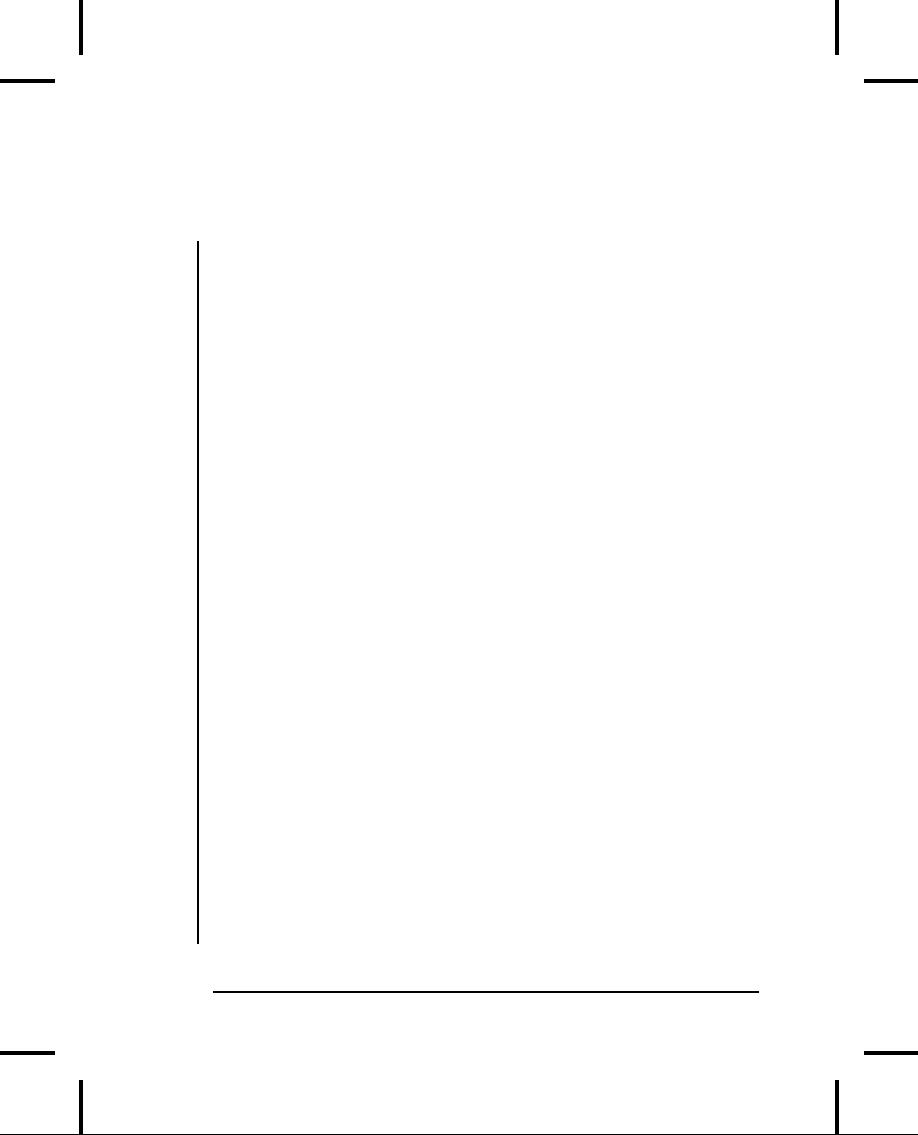
PStash
with iterators
For
most container classes it
makes sense to have an
iterator. Here's
an
iterator added to the
PStash
class:
//:
C16:TPStash2.h
//
Templatized PStash with
nested iterator
#ifndef
TPSTASH2_H
#define
TPSTASH2_H
#include
"../require.h"
#include
<cstdlib>
template<class
T, int incr = 20>
class
PStash {
int
quantity;
int
next;
T**
storage;
void
inflate(int increase =
incr);
public:
PStash()
: quantity(0), storage(0), next(0)
{}
~PStash();
int
add(T* element);
T*
operator[](int index)
const;
T*
remove(int index);
int
count() const { return next;
}
//
Nested iterator
class:
class
iterator; // Declaration
required
friend
class iterator; // Make it a
friend
class
iterator { // Now define
it
PStash&
ps;
int
index;
public:
iterator(PStash&
pStash)
:
ps(pStash), index(0) {}
//
To create the end
sentinel:
iterator(PStash&
pStash, bool)
:
ps(pStash), index(ps.next) {}
//
Copy-constructor:
iterator(const
iterator& rv)
:
ps(rv.ps), index(rv.index) {}
iterator&
operator=(const iterator& rv)
{
ps
= rv.ps;
index
= rv.index;
return
*this;
768
Thinking
in C++

}
iterator&
operator++() {
require(++index
<= ps.next,
"PStash::iterator::operator++
"
"moves
index out of
bounds");
return
*this;
}
iterator&
operator++(int) {
return
operator++();
}
iterator&
operator--() {
require(--index
>= 0,
"PStash::iterator::operator--
"
"moves
index out of
bounds");
return
*this;
}
iterator&
operator--(int) {
return
operator--();
}
//
Jump interator forward or
backward:
iterator&
operator+=(int amount) {
require(index
+ amount < ps.next &&
index
+ amount >= 0,
"PStash::iterator::operator+=
"
"attempt
to index out of
bounds");
index
+= amount;
return
*this;
}
iterator&
operator-=(int amount) {
require(index
- amount < ps.next &&
index
- amount >= 0,
"PStash::iterator::operator-=
"
"attempt
to index out of
bounds");
index
-= amount;
return
*this;
}
//
Create a new iterator that's
moved forward
iterator
operator+(int amount) const
{
iterator
ret(*this);
ret
+= amount; // op+= does
bounds check
return
ret;
}
T*
current() const {
return
ps.storage[index];
}
16:
Introduction to Templates
769

T*
operator*() const { return
current(); }
T*
operator->() const {
require(ps.storage[index]
!= 0,
"PStash::iterator::operator->returns
0");
return
current();
}
//
Remove the current
element:
T*
remove(){
return
ps.remove(index);
}
//
Comparison tests for
end:
bool
operator==(const iterator& rv) const
{
return
index == rv.index;
}
bool
operator!=(const iterator& rv) const
{
return
index != rv.index;
}
};
iterator
begin() { return iterator(*this);
}
iterator
end() { return iterator(*this,
true);}
};
//
Destruction of contained
objects:
template<class
T, int incr>
PStash<T,
incr>::~PStash() {
for(int
i = 0; i < next; i++) {
delete
storage[i]; // Null pointers
OK
storage[i]
= 0; // Just to be safe
}
delete
[]storage;
}
template<class
T, int incr>
int
PStash<T, incr>::add(T* element)
{
if(next
>= quantity)
inflate();
storage[next++]
= element;
return(next
- 1); // Index number
}
template<class
T, int incr>
inline
T*
PStash<T, incr>::operator[](int
index) const {
require(index
>= 0,
"PStash::operator[]
index negative");
if(index
>= next)
770
Thinking
in C++

return
0; // To indicate the
end
require(storage[index]
!= 0,
"PStash::operator[]
returned null
pointer");
return
storage[index];
}
template<class
T, int incr>
T*
PStash<T, incr>::remove(int index)
{
//
operator[] performs validity
checks:
T*
v = operator[](index);
//
"Remove" the pointer:
storage[index]
= 0;
return
v;
}
template<class
T, int incr>
void
PStash<T, incr>::inflate(int
increase) {
const
int tsz = sizeof(T*);
T**
st = new T*[quantity +
increase];
memset(st,
0, (quantity + increase) *
tsz);
memcpy(st,
storage, quantity *
tsz);
quantity
+= increase;
delete
[]storage; // Old
storage
storage
= st; // Point to new
memory
}
#endif
// TPSTASH2_H ///:~
Most
of this file is a fairly straightforward
translation of both
the
previous
PStash
and
the nested iteratorinto
a template. This
time,
however,
the operators return references to
the current iterator,
which
is the more typical and
flexible approach to
take.
The
destructor calls delete
for
all contained pointers, and
because
the
type is captured by the template,
proper destruction will
take
place.
You should be aware that if
the container holds pointers
to a
base-class
type, that type should have
a virtual
destructor
to ensure
proper
cleanup of derived objects
whose addresses have
been
upcast
when placing them in the
container.
The
PStash::iteratorfollows
the iterator model of
bonding to a
single
container object for its
lifetime. In addition, the
copy-
constructor
allows you to make a new iterator
pointing at the same
16:
Introduction to Templates
771

location
as the existing iterator
that you create it from,
effectively
making
a bookmark into the container.
The operator+=and
operator-=member
functions allow you to move an iterator by
a
number
of spots, while respecting the
boundaries of the
container.
The
overloaded increment and decrement
operators move the
iterator
by one place. The operator+produces
a new iterator that's
moved
forward by the amount of the addend. As
in the previous
example,
the pointer dereference
operators are used to
operate on
the
element the iterator is
referring to, and remove(
)destroys
the
current
object by calling the
container's remove(
)
.
The
same kind of code as before
(a
la the
Standard C++ Library
containers)
is used for creating the end
sentinel: a second
constructor,
the container's end(
) member
function, and
operator==and
operator!=for
comparison.
The
following example creates and tests two
different kinds of
Stash
objects,
one for a new class called
Int
that
announces its
construction
and destruction and one that
holds objects of the
Standard
library string
class.
//:
C16:TPStash2Test.cpp
#include
"TPStash2.h"
#include
"../require.h"
#include
<iostream>
#include
<vector>
#include
<string>
using
namespace std;
class
Int {
int
i;
public:
Int(int
ii = 0) : i(ii) {
cout
<< ">" << i << ' ';
}
~Int()
{ cout << "~" << i << ' ';
}
operator
int() const { return i;
}
friend
ostream&
operator<<(ostream&
os, const Int& x) {
return
os << "Int: " << x.i;
772
Thinking
in C++

}
friend
ostream&
operator<<(ostream&
os, const Int* x) {
return
os << "Int: " <<
x->i;
}
};
int
main() {
{
// To force destructor
call
PStash<Int>
ints;
for(int
i = 0; i < 30; i++)
ints.add(new
Int(i));
cout
<< endl;
PStash<Int>::iterator
it = ints.begin();
it
+= 5;
PStash<Int>::iterator
it2 = it + 10;
for(;
it != it2; it++)
delete
it.remove(); // Default
removal
cout
<< endl;
for(it
= ints.begin();it !=
ints.end();it++)
if(*it)
// Remove() causes
"holes"
cout
<< *it << endl;
}
// "ints" destructor called
here
cout
<< "\n-------------------\n";
ifstream
in("TPStash2Test.cpp");
assure(in,
"TPStash2Test.cpp");
//
Instantiate for
String:
PStash<string>
strings;
string
line;
while(getline(in,
line))
strings.add(new
string(line));
PStash<string>::iterator
sit = strings.begin();
for(;
sit != strings.end();
sit++)
cout
<< **sit << endl;
sit
= strings.begin();
int
n = 26;
sit
+= n;
for(;
sit != strings.end();
sit++)
cout
<< n++ << ": " << **sit <<
endl;
}
///:~
For
convenience, Int
has
an associated ostream
operator<< both
for
an
Int&
and
an Int*.
16:
Introduction to Templates
773

The
first block of code in
main(
) is
surrounded by braces to
force
the
destruction of the PStash<Int>and
thus the automatic
cleanup
by
that destructor. A range of
elements is removed and deleted
by
hand
to show that the PStash
cleans
up the rest.
For
both instances of PStash,
an iterator is created and used
to
move
through the container. Notice
the elegance produced
by
using
these constructs; you aren't
assailed with the
implementation
details
of using an array. You tell
the container and iterator
objects
what
to do, not
how. This makes the solution
easier to
conceptualize,
to build, and to modify.
Why
iterators?
Up
until now you've seen the mechanics of
iterators, but
understanding
why they are so important takes a
more complex
example.
It's
common to see polymorphism,
dynamic object creation,
and
containers
used together in a true object-oriented
program.
Containers
and dynamic object creation
solve the problem of
not
knowing
how many or what type of objects you'll need. And if
the
container
is configured to hold pointers to
base-class objects, an
upcast
occurs every time you put a
derived-class pointer into
the
container
(with the associated code
organization and extensibility
benefits).
As the final code in Volume 1 of
this book, this
example
will
also pull together various
aspects of everything you've
learned
so
far if you can follow this
example, then you're ready
for
Volume
2.
Suppose
you are creating a program
that allows the user to
edit and
produce
different kinds of drawings.
Each drawing is an object
that
contains
a collection of Shape
objects:
//:
C16:Shape.h
#ifndef
SHAPE_H
#define
SHAPE_H
774
Thinking
in C++

#include
<iostream>
#include
<string>
class
Shape {
public:
virtual
void draw() = 0;
virtual
void erase() = 0;
virtual
~Shape() {}
};
class
Circle : public Shape
{
public:
Circle()
{}
~Circle()
{ std::cout << "Circle::~Circle\n";
}
void
draw() { std::cout <<
"Circle::draw\n";}
void
erase() { std::cout <<
"Circle::erase\n";}
};
class
Square : public Shape
{
public:
Square()
{}
~Square()
{ std::cout << "Square::~Square\n";
}
void
draw() { std::cout <<
"Square::draw\n";}
void
erase() { std::cout <<
"Square::erase\n";}
};
class
Line : public Shape {
public:
Line()
{}
~Line()
{ std::cout << "Line::~Line\n";
}
void
draw() { std::cout <<
"Line::draw\n";}
void
erase() { std::cout <<
"Line::erase\n";}
};
#endif
// SHAPE_H ///:~
This
uses the classic structure
of virtual functions in the base
class
that
are overridden in the
derived class. Notice that
the Shape
class
includes
a virtual
destructor,
something you should
automatically
add
to any class with virtual
functions.
If a container holds
pointers
or
references to Shape
objects,
then when the virtual
destructors
are
called for those objects
everything will be properly cleaned
up.
16:
Introduction to Templates
775

Each
different type of drawing in the following
example makes use
of
a different kind of templatized container
class: the PStash
and
Stack
that
have been defined in this
chapter, and the vector
class
from
the Standard C++ Library.
The "use"' of the containers
is
extremely
simple, and in general inheritance might
not be the best
approach
(composition could make more
sense), but in this
case
inheritance
is a simple approach and it doesn't
detract from the
point
made in the example.
//:
C16:Drawing.cpp
#include
<vector> // Uses Standard
vector too!
#include
"TPStash2.h"
#include
"TStack2.h"
#include
"Shape.h"
using
namespace std;
//
A Drawing is primarily a container of
Shapes:
class
Drawing : public PStash<Shape>
{
public:
~Drawing()
{ cout << "~Drawing" << endl;
}
};
//
A Plan is a different container of
Shapes:
class
Plan : public Stack<Shape>
{
public:
~Plan()
{ cout << "~Plan" << endl;
}
};
//
A Schematic is a different container of
Shapes:
class
Schematic : public vector<Shape*>
{
public:
~Schematic()
{ cout << "~Schematic" <<
endl; }
};
//
A function template:
template<class
Iter>
void
drawAll(Iter start, Iter
end) {
while(start
!= end) {
(*start)->draw();
start++;
}
}
776
Thinking
in C++

int
main() {
//
Each type of container
has
//
a different interface:
Drawing
d;
d.add(new
Circle);
d.add(new
Square);
d.add(new
Line);
Plan
p;
p.push(new
Line);
p.push(new
Square);
p.push(new
Circle);
Schematic
s;
s.push_back(new
Square);
s.push_back(new
Circle);
s.push_back(new
Line);
Shape*
sarray[] = {
new
Circle, new Square, new
Line
};
//
The iterators and the
template function
//
allow them to be treated
generically:
cout
<< "Drawing d:" <<
endl;
drawAll(d.begin(),
d.end());
cout
<< "Plan p:" <<
endl;
drawAll(p.begin(),
p.end());
cout
<< "Schematic s:" <<
endl;
drawAll(s.begin(),
s.end());
cout
<< "Array sarray:" <<
endl;
//
Even works with array
pointers:
drawAll(sarray,
sarray
+ sizeof(sarray)/sizeof(*sarray));
cout
<< "End of main" <<
endl;
}
///:~
The
different types of containers all hold
pointers to Shape
and
pointers
to upcast objects of classes derived from
Shape.
However,
because
of polymorphism, the proper
behavior still occurs
when
the
virtual functions are
called.
Note
that sarray,
the array of Shape*,
can also be thought of as a
container.
16:
Introduction to Templates
777

Function
templates
In
drawAll(
)you
see something new. So far in
this chapter, we
have
been using only class
templates, which
instantiate new classes
based
on one or more type parameters. However,
you can as easily
create
function
templates, which
create new functions based on
type
parameters.
The reason you create a
function template is the
same
reason
you use for a class template: You're
trying to create generic
code,
and you do this by delaying the
specification of one or
more
types.
You just want to say that
these type parameters
support
certain
operations, not exactly what types they
are.
The
function template drawAll(
)can
be thought of as an algorithm
(and
this is what most of the
function templates in the
Standard
C++
Library are called). It just
says how to do something
given
iterators
describing a range of elements, as long
as these iterators
can
be dereferenced, incremented, and
compared. These are
exactly
the
kind of iterators we have been
developing in this chapter,
and
also
not coincidentally the kind of
iterators that are produced
by
the
containers in the Standard C++
Library, evidenced by the
use of
vector
in
this example.
We'd
also like drawAll(
)to
be a generic
algorithm, so that
the
containers
can be any type at all and we don't have to write a
new
version
of the algorithm for each
different type of container.
Here's
where
function templates are
essential, because they
automatically
generate
the specific code for each
different type of container. But
without
the extra indirection
provided by the iterators,
this
genericness
wouldn't be possible. That's why
iterators are
important;
they allow you to write general-purpose code
that
involves
containers without knowing the underlying
structure of
the
container. (Notice that, in
C++, iterators and generic
algorithms
require
function templates in order to
work.)
You
can see the proof of
this in main(
),
since drawAll(
)works
unchanged
with each different type of container.
And even more
interesting,
drawAll(
)also
works with pointers to the
beginning
778
Thinking
in C++

and
end of the array sarray.
This ability to treat arrays
as containers
is
integral to the design of
the Standard C++ Library,
whose
algorithms
look much like drawAll(
)
.
Because
container class templates
are rarely subject to
the
inheritance
and upcasting you see with "ordinary"
classes, you'll
almost
never see virtual
functions
in container classes.
Container
class
reuse is implemented with templates, not
with inheritance.
Summary
Container
classes are an essential
part of object-oriented
programming.
They are another way to simplify and
hide the
details
of a program and to speed the
process of program
development.
In addition, they provide a great
deal of safety and
flexibility
by replacing the primitive
arrays and relatively
crude
data
structure techniques found in C.
Because
the client programmer needs
containers, it's essential
that
they
be easy to use. This is
where the templatecomes
in. With
templates
the syntax for source-code
reuse (as opposed to
object-
code
reuse provided by inheritance and
composition) becomes
trivial
enough for the novice user.
In fact, reusing code
with
templates
is notably easier than inheritance and
composition.
Although
you've learned about creating
container and iterator
classes
in this book, in practice
it's much more expedient to
learn
the
containers and iterators in the
Standard C++ Library, since
you
can
expect them to be available with every
compiler. As you will
see
in Volume 2 of this book (downloadable
from
), the
containers and algorithms in the
Standard
C++
Library will virtually always fulfill your
needs so you don't
have
to create new ones
yourself.
The
issues involved with container-class
design have been
touched
upon
in this chapter, but you may have
gathered that they can
go
16:
Introduction to Templates
779

much
further. A complicated container-class
library may cover all
sorts
of additional issues, including
multithreading, persistence
and
garbage collection.
Exercises
Solutions
to selected exercises can be found in
the electronic document
The
Thinking in C++
Annotated
Solution
Guide,
available for a small fee
from .
1.
Implement
the inheritance hierarchy in
the OShape
diagram
in this chapter.
2.
Modify
the result of Exercise 1 from
Chapter 15 to use the
Stack
and
iteratorin
TStack2.hinstead
of an array of
Shape
pointers.
Add destructors to the class
hierarchy so
you
can see that the
Shape
objects
are destroyed when
the
Stack
goes
out of scope.
3.
Modify
TPStash.hso
that the increment value
used by
inflate(
)can
be changed throughout the lifetime of
a
particular
container object.
4.
Modify
TPStash.hso
that the increment value
used by
inflate(
)automatically
resizes itself to reduce
the
number
of times it needs to be called.
For example, each
time
it is called it could double
the increment value
for
use
in the next call.
Demonstrate this functionality
by
reporting
whenever an inflate(
)is
called, and write test
code
in main(
).
5.
Templatize
the fibonacci(
)function
on the type of value
that
it produces (so it can
produce long,
float,
etc. instead
of
just int).
6.
Using
the Standard C++ Library
vector
as
an underlying
implementation,
create a Set
template
class that accepts
only
one of each type of object
that you put into it.
Make
a
nested iteratorclass
that supports the "end
sentinel"
concept
in this chapter. Write test
code for your Set
in
main(
),
and then substitute the Standard C++
Library set
template
to verify that the behavior is
correct.
780
Thinking
in C++

7.
Modify
AutoCounter.hso
that it can be used as
a
member
object inside any class
whose creation and
destruction
you want to trace. Add a string
member
to
hold
the name of the class.
Test this tool inside a
class of
your
own.
8.
Create
a version of OwnerStack.hthat
uses a Standard
C++
Library vector
as
its underlying implementation.
You
may need to look up some of
the member functions
of
vector
in
order to do this (or just
look at the <vector>
header
file).
9.
Modify
ValueStack.hso
that it dynamically expands
as
you
push(
) more
objects and it runs out of space.
Change
ValueStackTest.cpp
test
the new functionality.
to
10.
Repeat
Exercise 9 but use a Standard C++
Library vector
as
the internal implementation of
the ValueStack
Notice
.
how
much easier this is.
11.
Modify
ValueStackTest.cpp
that
it uses a Standard
so
C++
Library vector
instead
of a Stack
in
main(
).
Notice
the
run-time behavior: Does the
vector
automatically
create
a bunch of default objects when it is
created?
12.
Modify
TStack2.hso
that it uses a Standard C++
Library
vector
as
its underlying implementation. Make
sure that
you
don't change the interface, so
that TStack2Test.cpp
works
unchanged.
13.
Repeat
Exercise 12 using a Standard C++
Library stack
instead
of a vector
(you
may need to look up
information
about
the stack,
or hunt through the <stack>
header
file).
14.
Modify
TPStash2.hso
that it uses a Standard
C++
Library
vector
as
its underlying implementation.
Make
sure
that you don't change the
interface, so that
TPStash2Test.cpp
works
unchanged.
15.
In
IterIntStack.cppmodify
IntStackIterto
give it an
,
"end
sentinel" constructor, and add
operator==and
operator!=
In
main(
),
use an iterator to move through
.
16:
Introduction to Templates
781

the
elements of the container until you
reach the end
sentinel.
16.
Using
TStack2.h
TPStash2.h and
Shape.h,
instantiate
,
,
Stack
and
PStash
containers
for Shape*,
fill them each
with
an assortment of upcast Shape
pointers,
then use
iterators
to move through each container and call
draw(
)
for
each object.
17.
Templatize
the Int
class
in TPStash2Test.cpp
that
it
so
holds
any type of object (feel free to
change the name of
the
class to something more
appropriate).
18.
Templatize
the IntArrayclass
in
IostreamOperatorOverloading.cpp
from
Chapter 12,
templatizing
both the type of object that
is contained and
the
size of the internal
array.
19.
Turn
ObjContainerin
NestedSmartPointer.cpp
from
Chapter
12 into a template. Test it with two
different
classes.
20.
Modify
C15:OStack.hand
C15:OStackTest.cpp
by
templatizing
class
Stackso that it
automatically multiply
inherits
from the contained class and from
Object.
The
generated
Stack
should
accept and produce only
pointers
of
the contained type.
21.
Repeat
Exercise 20 using vector
instead
of Stack.
22.
Inherit
a class StringVectorfrom
vector<void*>and
redefine
the push_back(
)and
operator[]member
functions
to accept and produce only string*
(and
perform
the proper casting). Now
create a template
that
will
automatically make a container
class to do the same
thing
for pointers to any type. This
technique is often
used
to reduce code bloat from
too many template
instantiations.
23.
In
TPStash2.h
add
and test an operator-to
,
PStash::iteratorfollowing
the logic of operator+
,
.
24.
In
Drawing.cpp
add
and test a function template to
call
,
erase(
)member
functions.
782
Thinking
in C++

25.
(Advanced)
Modify the Stack
class
in TStack2.hto
allow
full
granularity of ownership: Add a flag to
each link
indicating
whether that link owns the
object it points to,
and
support this information in
the push(
) function
and
destructor.
Add member functions to read and
change
the
ownership for each link.
26.
(Advanced)
Modify PointerToMemberOperator.cpp
from
Chapter 12 so that the
FunctionObjectand
operator->*are
templatized to work with any return type
(for
operator->*
you'll
have to use member
templates,
,
described
in Volume 2). Add and test support for
zero,
one
and two arguments in Dog
member
functions.
16:
Introduction to Templates
783
Table of Contents:
- Introduction to Objects:The progress of abstraction, Extreme programming
- Making & Using Objects:Tools for separate compilation, Reading and writing files
- The C in C++:Creating functions, Controlling execution, Introduction to operators
- Data Abstraction:The basic object, Abstract data typing, Header file etiquette
- Hiding the Implementation:C++ access control, Handle classes
- Initialization & Cleanup:Guaranteed cleanup with the destructor, Aggregate initialization
- Function Overloading & Default Arguments:Overloading example, Default arguments
- Constants:Function arguments & return values, Classes, volatile
- Inline Functions:Preprocessor pitfalls, Stash & Stack with inlines, Reducing clutter
- Name Control:Static elements from C, Static initialization dependency, specifications
- References & the Copy-Constructor:The copyconstructor, Pointers to members
- Operator Overloading:Overloadable operators, Overloading assignment
- Dynamic Object Creation:Early examples redesigned, new & delete for arrays
- Inheritance & Composition:The constructor initializer list, Name hiding
- Polymorphism & Virtual Functions:The problem, How C++ implements late binding
- Introduction to Templates:Template syntax, Stack and Stash as templates
- A: Coding Style
- B: Programming Guidelines
- C: Recommended Reading:Depth & dark corners, Analysis & design
- Index